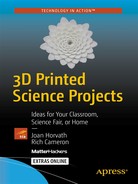Introduction
When we started our 3D-printing and makertech consulting company, we joked that we were going to call it “Now What?” because that was what schools seemed to say after they bought a 3D printer. We hope that this book takes a step toward answering that question.
We saw that students, parents, and teachers would be excited about using a 3D printer, might download a 3D model, print it, and then wonder what to do next. Or, they might get into creating models from scratch, and get discouraged by the limitations of easier 3D-modeling programs or the learning curves of the more capable ones.
In this book, we try to create a middle path: models that you could just print, but that would be reasonably easy to alter if you wanted to do more. Further, we designed the models so that they would be useful for learning science or math principles while you were changing their features. In particular we wanted to create some seeds of science fair or extra-credit projects—that is, open-ended, meaty explorations that could be explored at a variety of levels.
We were surprised at how hard this turned out to be. Most textbooks and online sites endlessly recycle versions of the same 2D projection of models of science concepts. In each chapter, we have a “Learning Like a Maker” section where we talk about our adventures in defining and implementing the models—which in some cases involved finding online copies of 1935 manuscripts (signed off by a Wright brother and Charles Lindbergh!) and in others meant figuring out what to do after a scientific experts who implied that everyone teaches the subject at hand the way it is drawn in textbooks, but you unlearn all that in grad school to get to the real way.
This book presumes that you know a little bit about 3D printing already. If not, Appendix A and the resources linked there should get you up to speed. The models are all written using the OpenSCAD free and open source 3D-modeling program. If you know how to program in a language like C, Java, or Python, that will help, but it’s not strictly necessary to alter the models. Appendix A and the OpenSCAD materials linked there will help you out with that too.
We have found that teachers use 3D printers in one of two fundamental ways. Either they want to create a model to pass around in class to help students visualize a concept, or they want students to use a printer either to learn engineering and design per se or to cement physical concepts like levers and gears. Since most of these models would lend themselves to being used either way, we have not included a grade level or explicit lesson plans.
To show our readers who are teachers (in the United States) what we had in mind, though, at the end of most chapters we suggest Next Generation Science Standards that we thought might benefit from these models. These science standards, from the group NGSS Lead States, are documented in Next Generation Science Standards: For States, By States (The National Academies Press, 2013). Links are given at the end of relevant chapters. If you are a teacher, you may want to check with your state or school standards as well to see the best fit.
The models span a variety of topics, and we tried to cover as many disciplines as possible. Briefly, here is what you can look forward to:
Chapter 1 gives you a few options to print many different types of mathematical surface. This ability underlies some of the other models.
Chapter 2 creates models of waves to allow you to explore what happens when various waves overlap and interact. You can print yourself a model of Young’s famous double-slit experiment to see how light from two slits can interfere.
Chapter 3 takes us back to Newton and Kepler to learn about planets and stars and how they speed up and slow down in their orbits.
Chapter 4 allows you to create wings with classic airfoil shapes from the early days of flight. You will be able to make yourself a very simplistic test stand that you can use to measure the lift from the wing with just a fan and a postal scale.
Chapter 5 lets you create basic models of all the “simple machines”—wedge, inclined plane, lever, pulleys, and screws.
Chapter 6 allows you to model plants and their ecosystems, and to design plants for different environments. Maybe you can create a garden for another planet (or for Earth after another few hundred years of climate change).
Chapter 7 lets you begin to explore carbon atoms, and how water molecules come together to make two different types of ice crystals.
Chapter 8 explores 2D and 3D trusses and how you can use them in various explorations.
As we noted earlier, Appendix A reviews how to 3D print, and Appendix B aggregates all the links in the book.
Finally, we are making the 3D-printable models used in this book (although not the book itself!) open source, licensed under a Creative Commons Attribution-NonCommerical-ShareAlike 4.0 International License (https://creativecommons.org/licenses/by-nc-sa/4.0/). That means you can use them for noncommercial purposes (in a classroom, for instance) and alter and remix them as long as you credit us. Appendix A has some notes about where to find the repositories if you would like to add to these models. We hope these models are the beginning of a set of models that students everywhere can play with and learn from.
